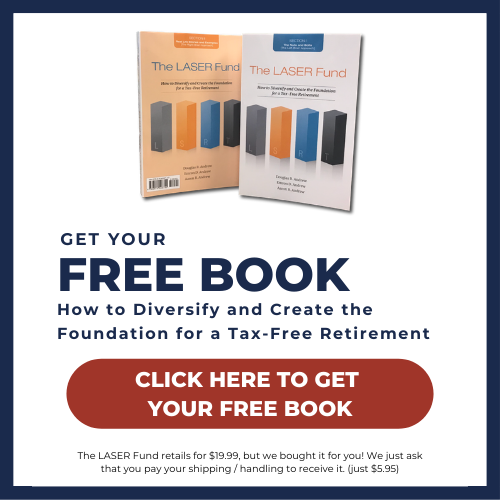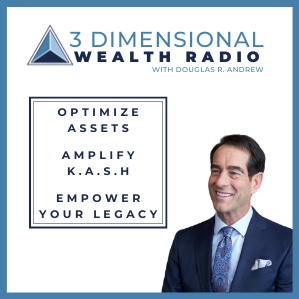Warren Buffett has two rules of investing: Rule, #1, don’t lose money. Rule #2? Don’t forget Rule #1. Well, sometimes that’s easier said than done, especially when you own a 401(k). Let me show you how to protect that money from stock market crashes.
If you had a 401(k) in the 2000s, you already know how this story goes. From 2000 to 2003, millions of Americans with traditional investments in the market lost 40% of their account values, thanks to the dot-com bust and 9/11. Their accounts barely had time to recover when in 2008, they lost 40% again at the start of the Great Recession.
Those who were younger at the time at least had the hope of plenty of years ahead for their accounts to recover. But for those who were near or at retirement? It was a huge blow to their peace of mind and financial security.
At the same time in history, thousands of our clients who had their serious money set aside in properly structured, maximum-funded Indexed Universal Life policies (what I call LASER Funds), didn’t lose a dime of principal due to market volatility. They sailed through those storms on calm seas, because their money was LINKED TO the market, not IN the market.
By now you can probably guess my answer to the question: “How do you protect 401(k)s from stock market crashes?”
I’d actually rephrase the question: “How do you protect your money from stock market crashes?”
JUST DON’T
Don’t put it in a 401(k).
I’ve never owned a 401k, and I never will. Even if I did, it would not be invested in the market. Yet, most Americans have their money in tax-deferred IRAs and 401(k)s invested in the market.
As experienced by all those folks in the 2000s, the last thing that you should be doing at retirement is having your hard-earned money you’ve set aside exposed to market volatility. The pitfalls of money invested in the market have at times, historically, caused people to put off retirement for up to seven years (waiting for the market to come back). Or they’ve had to tighten their belt, or they’ve lived in fear of outliving their money.
As Will Rogers once said, “When things get tough, people get more concerned about the return of their money than the return on their money.” So the concept here is how to watch your money grow when the market goes up, while protecting your principal from loss when the market goes down.
For a deeper look, jump over to my article, “What Is Indexed Universal Life–And How Does It Work?, but I’ll cover the highlights here.
THE YO-YO EFFECT
I often compare the stock market to a person with a yo-yo. The yo-yo is going up and down, up and down, just like the market. If the person is walking up stairs, that fluctuation is manageable, because overall you’re elevating your situation. But what happens when the person is walking downstairs? That downward trend can be damaging.
The challenge is a 25% loss has to be followed by a 33% gain to get back your money, to get back to breakeven. So if you have $100,000, with a 25% loss it goes down to $75,000. That $75,000 has to increase by a third, $25,000, to get back to breakeven.
What if you have a 33% loss? That has to be followed by a 50% gain. How about a 50% loss? Now you’re looking at a 100% gain to get back to breakeven. So if you have $100,000 drop to $50,000, that $50,000 has to double, or have a 100% increase to make up for a 50% loss.
The myth is: Wall Street is always up 50%, down 50%, up 50%, down 50%. So don’t worry, it’s like a net of zero.
But no, it isn’t. If the market goes, let’s say, up 50% and you have $100,000 in the S&P 500, you now have $150,000. The next year, the market loses 50%, so your $150,000 is now $75,000. The following year the market rebounds by 50%, so your $75,000 is now $112,500. If you lose 50% of that the following year, your account value is down to $56,000. In just a few years, you’ve lost nearly 44% of your original principal.
So why do you want to lose in the first place?
INDEXING, SIMPLIFIED
Indexing is what can make it possible to link your policy to the market while not having it actually in the market–so you can gain in up years, and be protected from a 0% guaranteed floor during down years.
One of the beauties of indexing is every year you get to lock-in any gains that you made the previous year and reset. What does that mean? It’s sort of like a ratchet wrench. You know when you use a ratchet wrench and you tighten a nut or a bolt? You’re tightening, and then you reset, click, click, click, click, but you don’t retrogress. You don’t loosen the bolt because it’s resetting.
So with lock-in and reset, there are years that the market goes up and you make money. But unlike the people with their money at risk in the market, you don’t lose when the market goes down. Your previous gains are locked in, and you’re protected by a 0% guaranteed floor that year.
Many of our clients who were protected by that 0% floor in 2008 were able to lock-in gains of 16% the first 90 days of 2009. That means that even if the market had crashed again in 2010, they would have kept those 16% gains they made in 2009.
Here’s another example: In 2017, many people using indexing locked-in gains of 16%, some as much as 25%. The next year, 2018, was sort of a ho-hum year. But for illustration purposes, let’s pretend that in 2018 there was a huge crash. What would have happened?
Let’s say one of our clients, we’ll call her Serena, had a $1 million dollar nest egg in a LASER Fund. With 25% gains, she would have made $250,000, ending 2017 with an account value of $1,250,000. Let’s say the next year the market crashed by 40%. Serena wouldn’t have lost 40%; she would still have $1,250,000. Let’s say in 2019, things turned things around, and she was on her way to higher account values again.
She wouldn’t have to wait a year or two to make up for what she lost, like others with their money in the market. That’s thanks to lock-in and reset. It knocks the socks off of having your money in the market and waiting around for one, two, three, four or more years to make up for the losses–and sometimes catastrophic losses in a single year.
So what do you do if you want to move money out of 401(k)s and IRAs into the liquidity, safety, predictable rates of return, and tax advantages of LASER Funds?
This is where you want to work with experienced IUL specialists, the folks who know that to be in accordance with tax laws, you can’t put that money in all at once. In fact, it takes about five years to satisfy what is called the Technical and Miscellaneous Revenue Act of 1988 (TAMRA). Experienced IUL specialists can help you decide how much of your money to reposition, and how to protect your money as much as possible while making that transition.
THE 4 BUCKETS
I recommend maintaining a diverse portfolio, with your money in what I call the 4 Buckets:
- Tax-Free Bucket
- Investment Bucket
- Real Estate Bucket
- Guaranteed Bucket
Typically I recommend no more than 30% of your retirement resources coming from money in the market. You want to get at least 40% to 60% of your money over to the tax-free bucket like a LASER Fund, and the rest can be spread over the real estate and guaranteed bucket.
There’s so much more to explore with all of this as you plan for a brighter future–I invite you to learn more.
WANT TO LEARN MORE?
Watch the Video – Watch the related YouTube video to see me explain “How to Protect 401(k) from Stock Market Crashes” (and while you’re there, be sure to subscribe to my YouTube channel so you don’t miss a thing!).
Elevate Your Financial Dimension – Find out how you can improve your Financial Dimension journey and seize the liquidity, safety, predictable rates of return, and tax advantages of a LASER Fund. Explore the in-depth financial strategies and learn from real-life client experiences by claiming your free copy of “The LASER Fund” book at LASERFund.com. Just pay for shipping and handling, and we will send it to you, absolutely free.
Join a Webinar – Want to find out if a LASER Fund (a maximum-funded, properly structured indexed universal life insurance policy) is right for you? Join us for an upcoming webinar where you can explore these strategies.


